Groan. You’re in a co-marketing funk. It seems like everybody’s hosting some clever online event you don’t want to miss, so how could you possibly get creative and do something different?

“It can be easy to do very poorly. The idea of ‘Let’s go do webinars and email campaigns and joint blog posts’ sounds good, but do we really need more of that?” says Shay Howe, VP of Platform Strategy at customer experience automation platform ActiveCampaign. “It’s about the signal to noise ratio. How do we get and keep people’s attention?”
Sometimes you need a real success story to help you look at co-marketing with a fresh perspective — so we’re sending some co-marketing inspiration into the ether.
Approximately six months following their first co-marketing initiative in May of 2019, ActiveCampaign made the #1 spot for marketing automation apps in Salesforce’s AppExchange.
Howe says the success of the ActiveCampaign-Salesforce integration adoption is largely due to:
- Inviting Salesforce to team up with ActiveCampaign at the Digital Summit conference series, which ActiveCampaign sponsored and participated in in cities across the U.S.
- Building on that momentum to invite their most strategic accounts to their owned event series called “Study Halls”
The accounts who attended ActiveCampaign’s Study Hall sessions saw an increase in integration adoption rate and annual contract value (ACV), along with a reduction in churn.

It took a lot of work from the ActiveCampaign team to get to this point. We’re walking you through the ActiveCampaign-Salesforce co-marketing timeline month by month so you can see every moving part that brought this campaign to success — all in one place.
A Brief Campaign Timeline (Late 2018 – 2020)
Six Months Before Launch
In late 2018, the ActiveCampaign team knew they wanted to collaborate with Salesforce to develop an integration and go to market together. So, ActiveCampaign reached out to start the conversation with the goal of bringing the integration public in mid 2019.
ActiveCampaign and Salesforce identified their joint customers, determined which customers would be most likely to adopt, and made the case to their leadership teams for a long-term, all-hands-on-deck partnership.
Psst! You can identify joint customers with your partner by mapping accounts for free in Crossbeam.
“We called a bunch of them and asked, ‘Would you want to pilot the integration and use it before anyone else, and be a beta tester?’” explains Howe. “And also, ‘How do you want to use it? What are you doing today to try to connect data across these tools? How do we make that easier?’”
You can read more about the use cases in this article, “11 Salesforce Automations to Make the Most Out of Your Integration,” which maps them all out (hint: this isn’t the last time you’ll see this co-marketing asset!).
Then, the ActiveCampaign and Salesforce teams began preparing their co-marketing materials in anticipation of launch day.
We all know it’s not just about creating the AppExchange listing and giving yourself a pat on the back for a job well done. As is the bittersweet beauty of co-marketing, there are many assets — big and small — that ActiveCampaign and Salesforce needed to develop to make sure people could find the right information in the right places — no matter which channel they would arrive from.
Here’s a quick rundown of a few of the co-marketing materials ActiveCampaign and Salesforce prioritized to prepare for the upcoming launch:
- Copy and images for their respective listings on ActiveCampaign’s App Marketplace and Salesforce’s AppExchange (inclusion in each directory and dedicated pages explaining the integration)
- App spotlight section on ActiveCampaign’s “apps and integrations” homepage
- Help center page on ActiveCampaign’s and Salesforce’s sites explaining how to set up the integration
- Co-branded landing pages for potential integration adopters on ActiveCampaign and Salesforce’s websites (note: ActiveCampaign’s listing page doubles as their landing page)
- Trial offer form on Salesforce’s site
 ActiveCampaign’s listing on Salesforce’s AppExchange
ActiveCampaign’s listing on Salesforce’s AppExchange
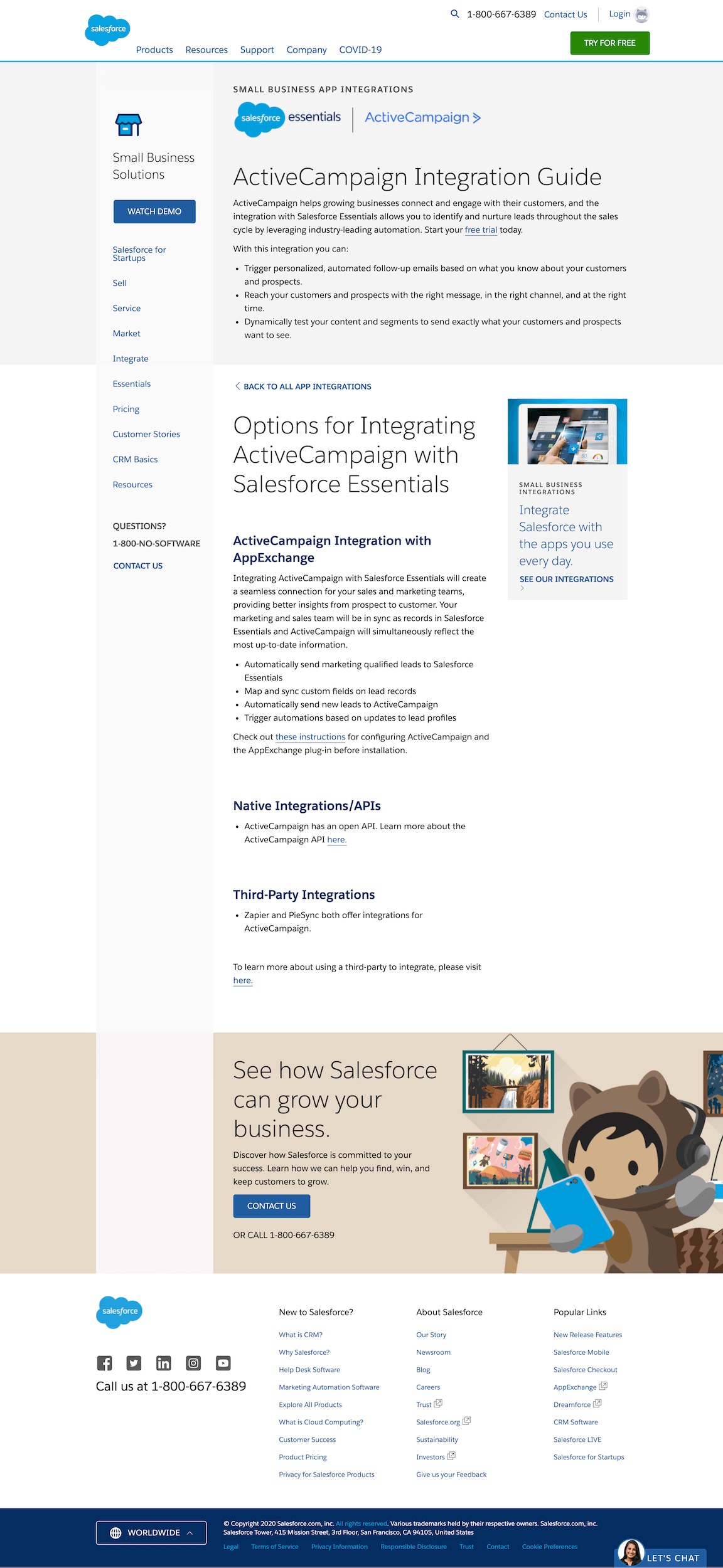 ActiveCampaign’s dedicated integration guide on the Salesforce site
ActiveCampaign’s dedicated integration guide on the Salesforce site
 Salesforce’s listing in ActiveCampaign’s App Marketplace
Salesforce’s listing in ActiveCampaign’s App Marketplace
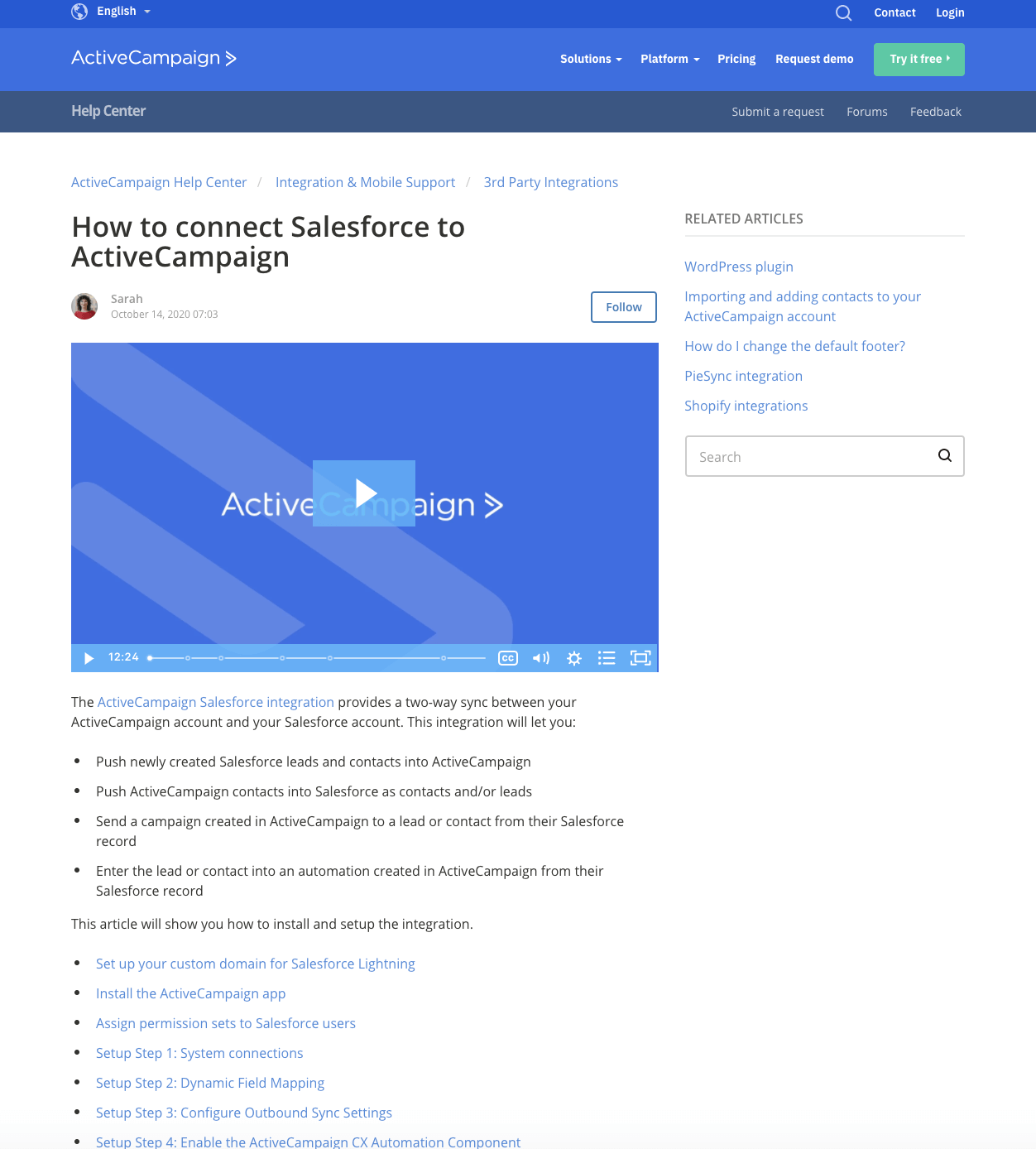 ActiveCampaign’s Salesforce integration help doc
ActiveCampaign’s Salesforce integration help doc
ActiveCampaign went a step further and made Salesforce front and center on their “apps and integrations” page.
 ActiveCampaign’s “apps and integrations” page
ActiveCampaign’s “apps and integrations” page
ActiveCampaign also promoted the integration on their in-platform login page for customers.

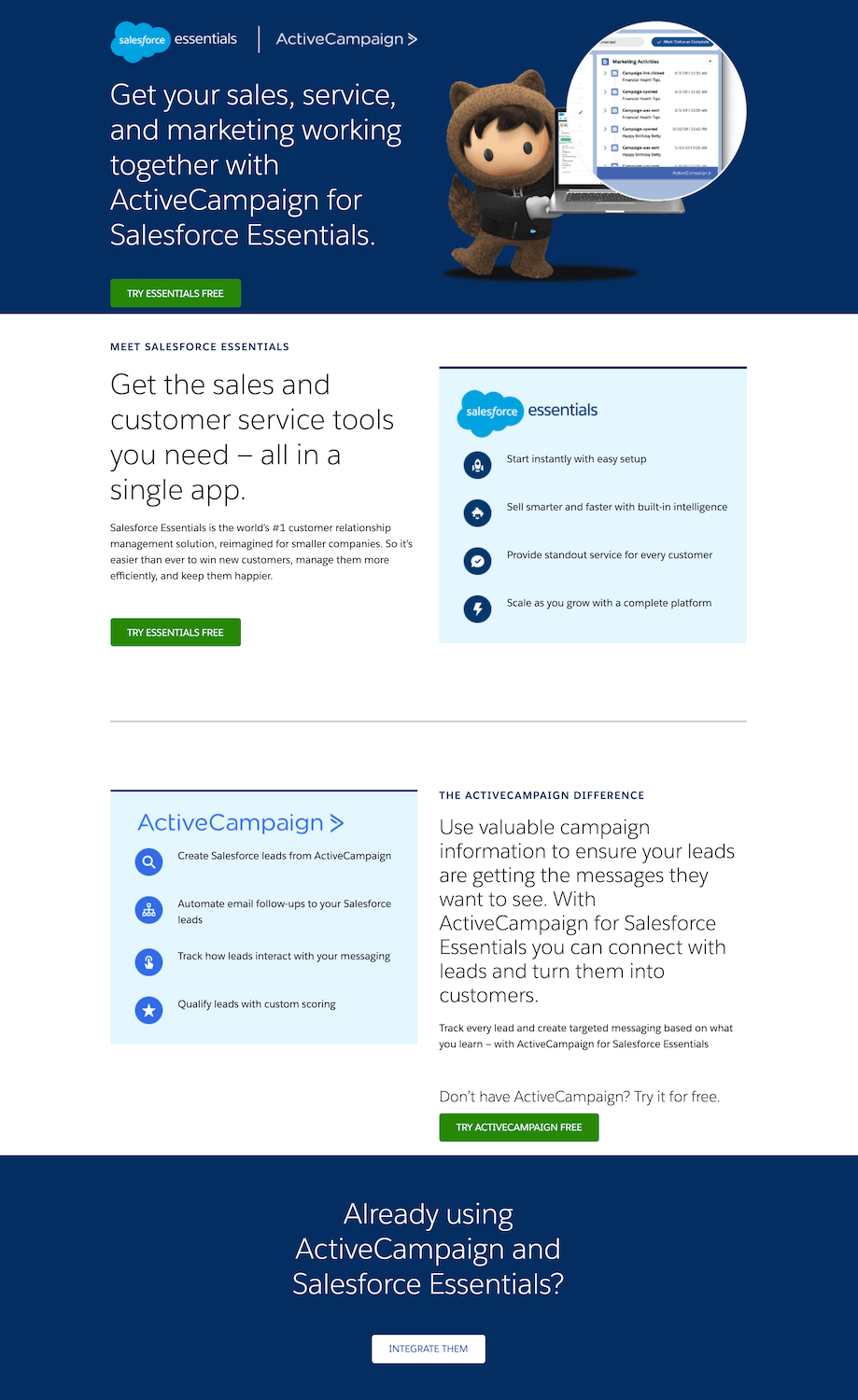 Salesforce’s co-branded landing page
Salesforce’s co-branded landing page
Salesforce put together a trial offer form for folks looking to try out the integration before fully adopting it.
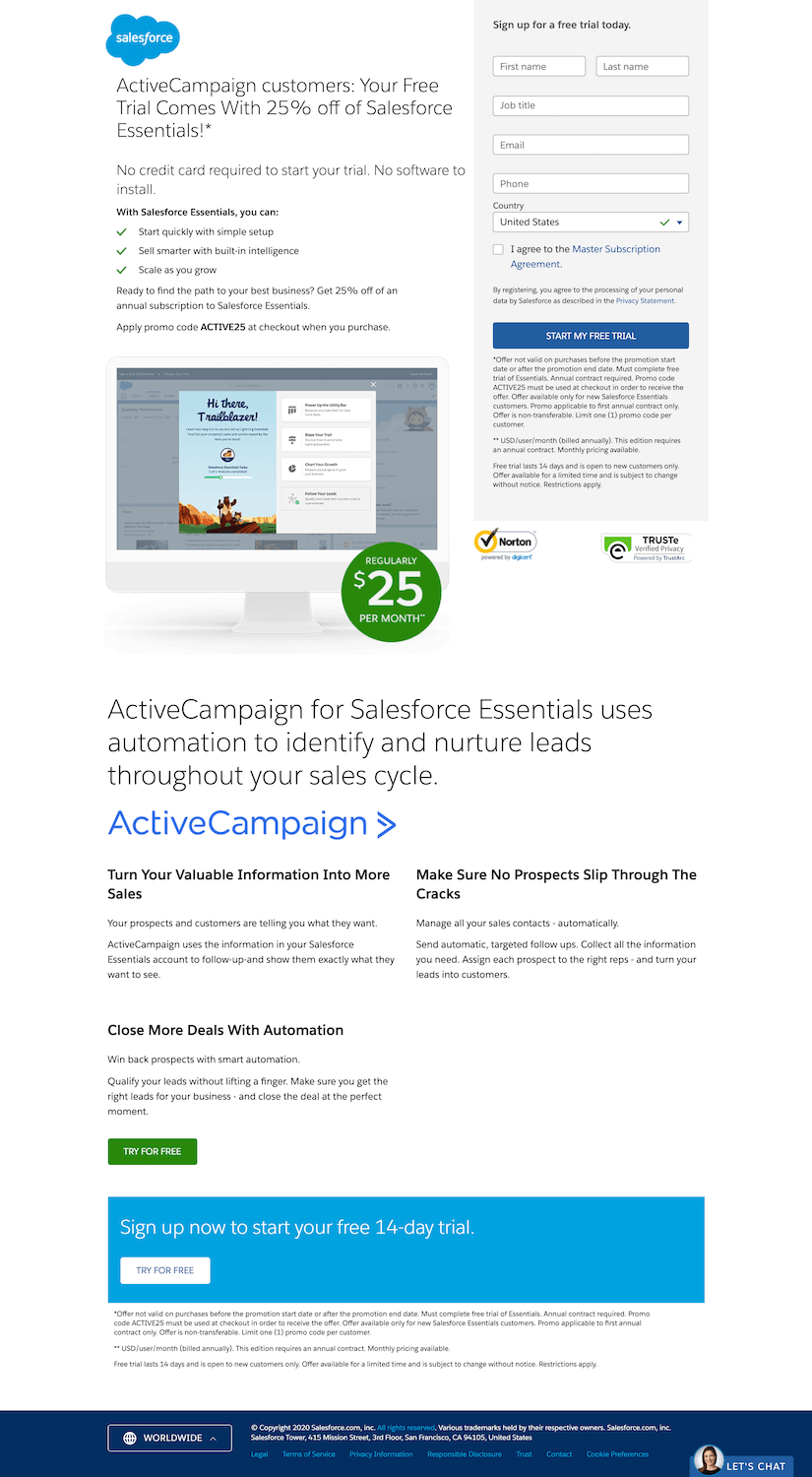
ActiveCampaign even plugged Salesforce as one of three featured apps in their site’s bottom navigation. Sneaky, sneaky.

May 2019 (Three Months Before Launch)
ActiveCampaign invited Salesforce to co-host fireside chats with them at Digital Summits in cities around the U.S. Digital Summits are multi-day, digital marketing conferences hosted by TechMedia.
ActiveCampaign leveraged their sponsorship of the conference series as a way to get the word out about the integration and raise awareness with their customers in the months leading up to and following the integration announcement in August.
Digital Summits welcomed anywhere between 500 to thousands of attendees — many of which included ActiveCampaign’s joint customers with Salesforce.
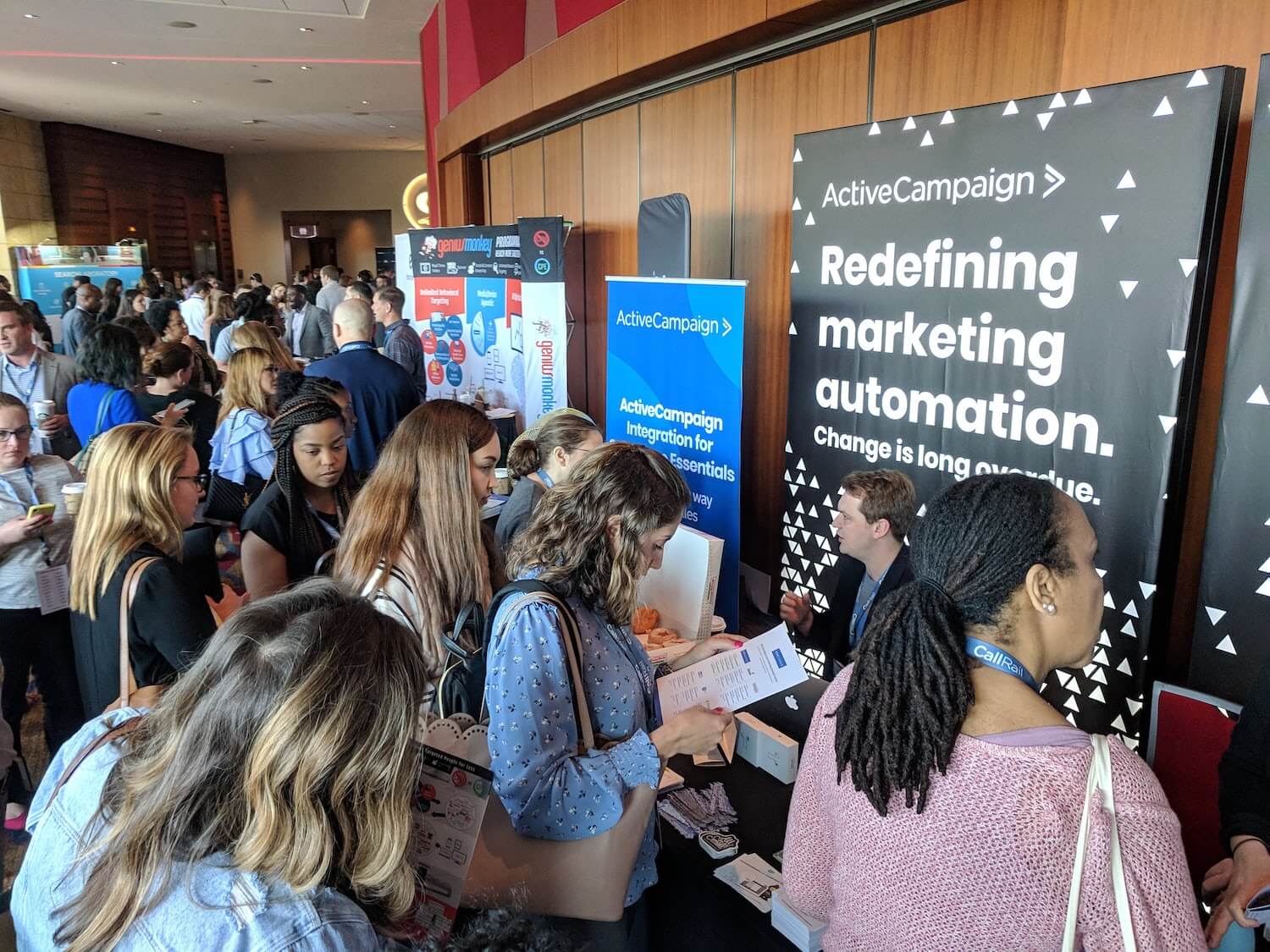 ActiveCampaign’s booth at a Digital Summit in Atlanta, May 2019
ActiveCampaign’s booth at a Digital Summit in Atlanta, May 2019
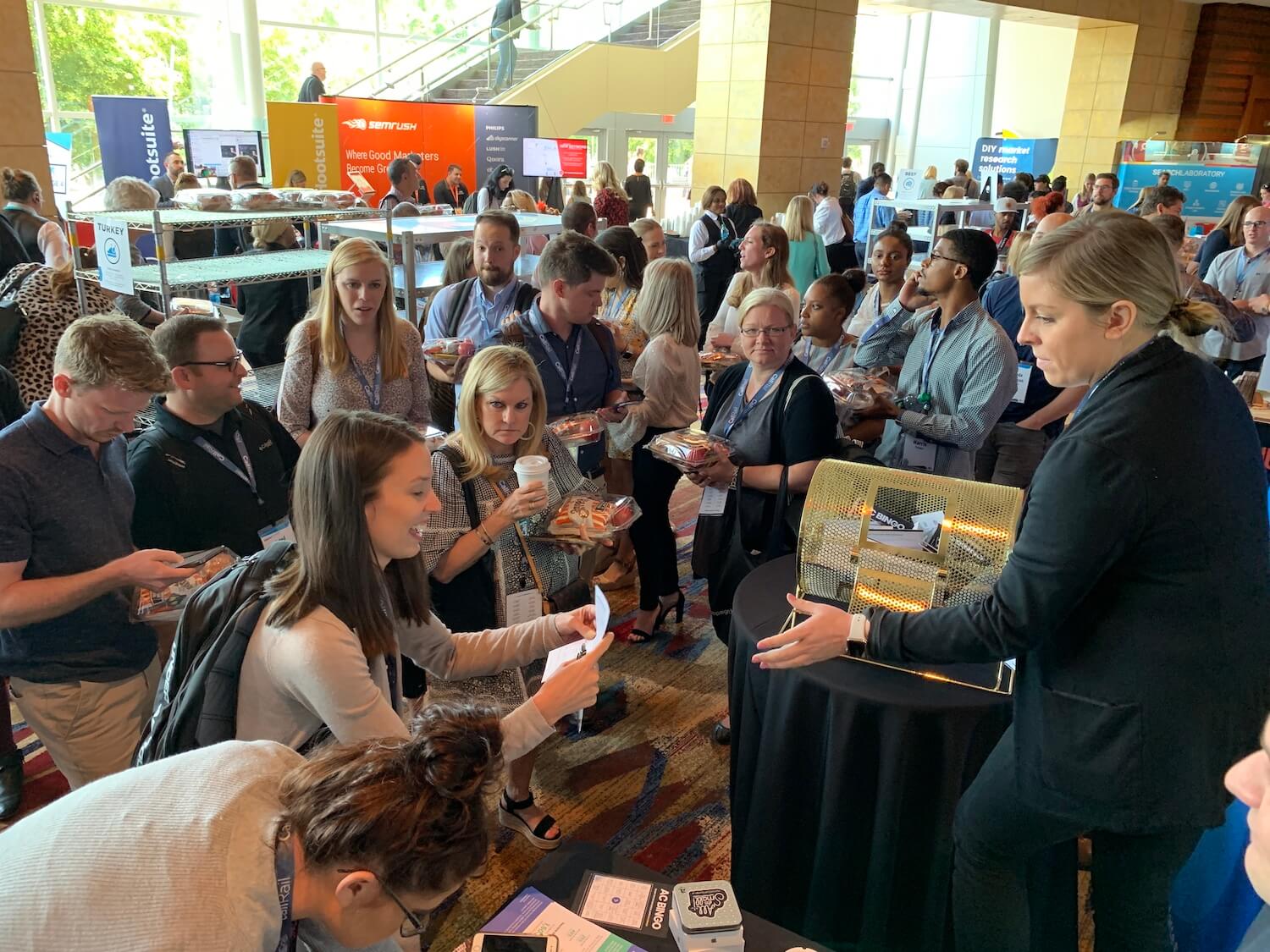 ActiveCampaign’s booth at a Digital Summit in Atlanta, May 2019
ActiveCampaign’s booth at a Digital Summit in Atlanta, May 2019
In Atlanta, ActiveCampaign and Salesforce hosted, “Getting to SQL: Sales and Marketing Alignment to Fill the Funnel” to dig into sales and marketing workflow automation (naturally).

 ActiveCampaign’s Shay Howe and Salesforce’s Thomas Kuppens at Digital Summit, May 2019
ActiveCampaign’s Shay Howe and Salesforce’s Thomas Kuppens at Digital Summit, May 2019
At the event, Howe and Salesforce’s Senior Manager of Growth Business, Thomas Kuppens, spoke about the upcoming integration and invited their joint customers to ActiveCampaign’s upcoming Study Hall.
 Front side of ActiveCampaign’s one-pager explaining the integration
Front side of ActiveCampaign’s one-pager explaining the integration
 Back side of ActiveCampaign’s one-pager explaining the integration
Back side of ActiveCampaign’s one-pager explaining the integration
Strategically, ActiveCampaign planned their Study Hall events in each market approximately two to four weeks following their participation in the particular city’s Digital Summit. They even brought “Free Admission” coupons to hand out to Digital Summit attendees.
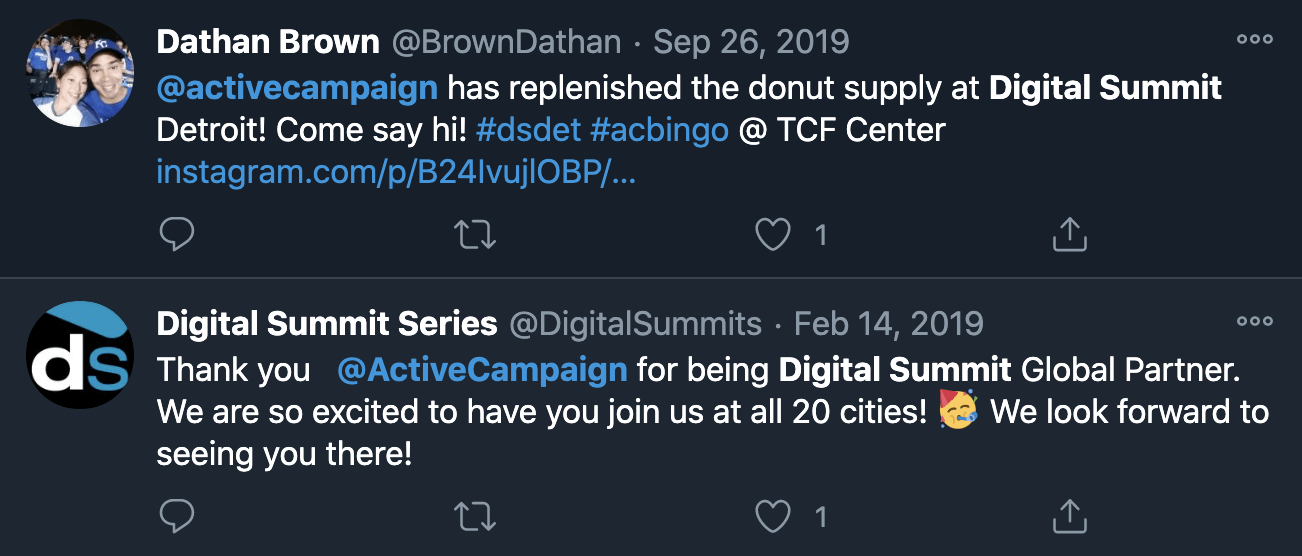
In the week following Digital Summit, the ActiveCampaign team circled back with customers they interacted with at the event to send them personal invitations to Study Hall.
Since Digital Summits draw such large audiences, ActiveCampaign didn’t need to promote the event much on their own platforms to engage their customers. They did, however, email individuals from accounts they thought may be attending to let them know they’d be at the summit and to say hello.
Note: As you can tell, the ActiveCampaign team is a regular at Digital Summits. While a one-off booth and fireside chat may not show the best return on investment for your company, leveraging conferences strategically with partners can help you get the word out about an upcoming or recent launch — especially when you’ve already established your company as a “familiar face” to attendees over time.
July 2019 (One Month Before Launch)
At the end of July, Howe wrote a guest post in the small business section of Salesforce’s blog. There’s no mention of the integration, so you can think of this post as a warm-up for what’s to come.
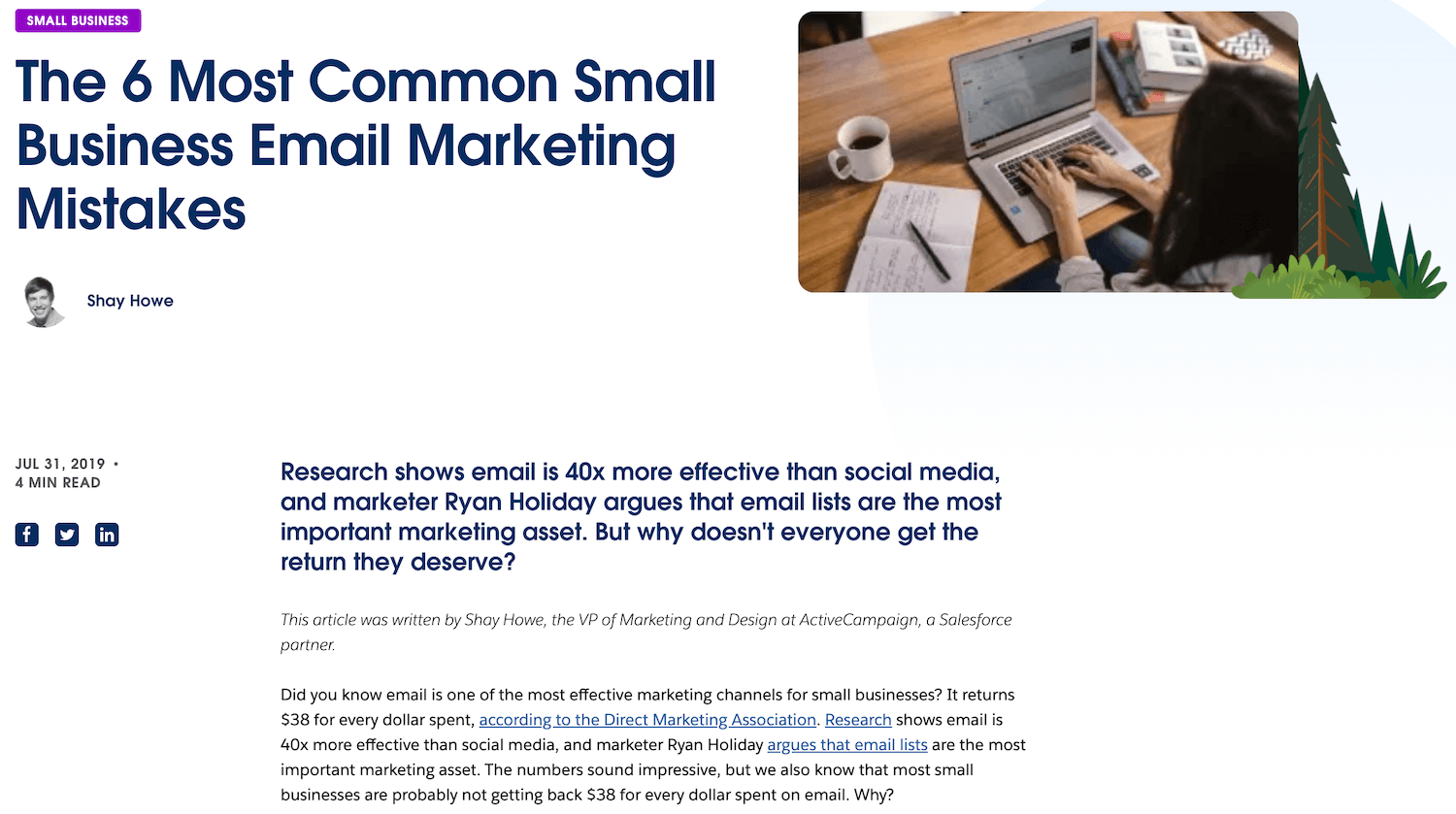
August 2019
ActiveCampaign and Salesforce announced the partnership in August with a press release on PR Newswire and a blog post announcement on ActiveCampaign’s blog.
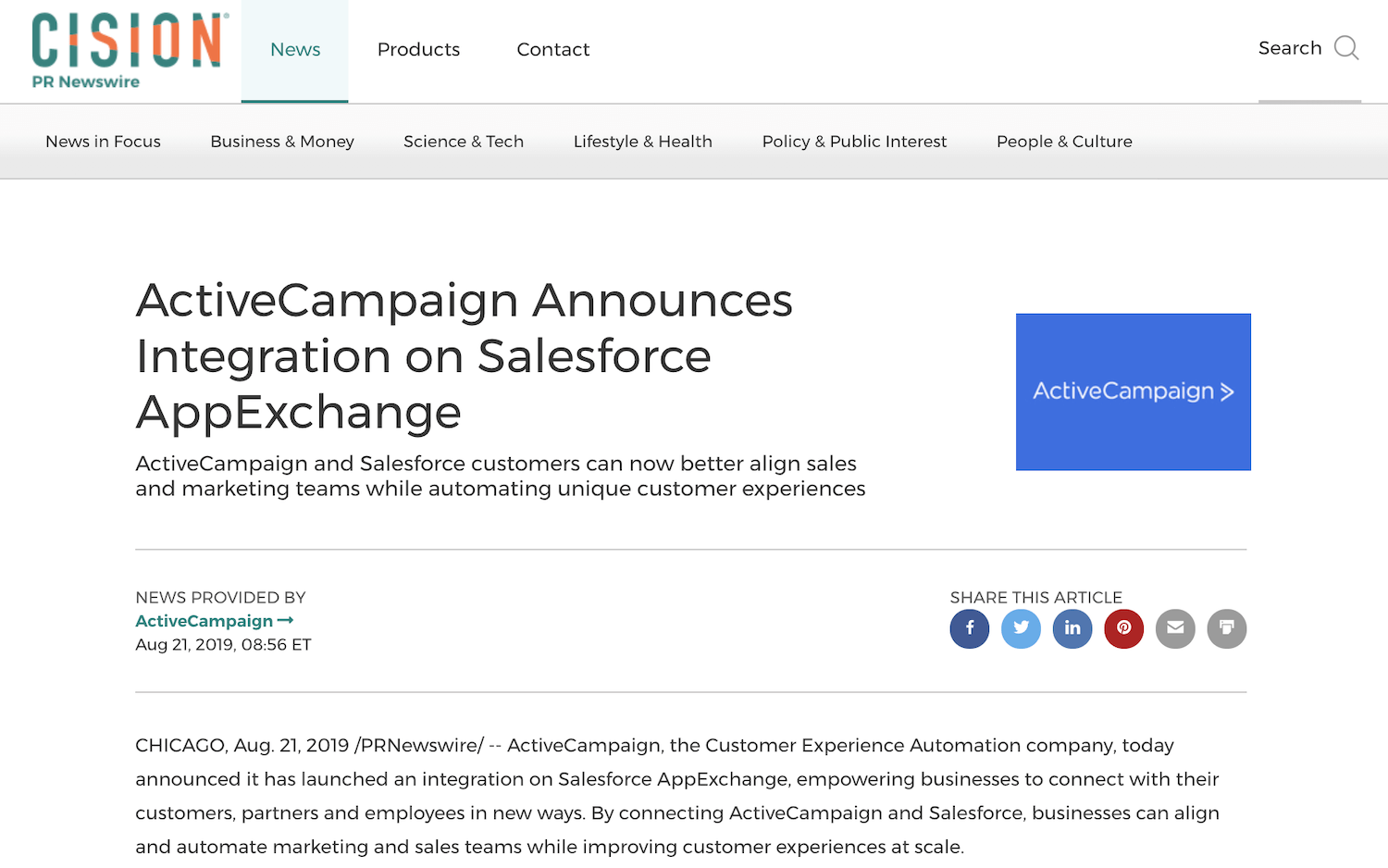 Excerpt from ActiveCampaign and Salesforce’s press release announcing the integration
Excerpt from ActiveCampaign and Salesforce’s press release announcing the integration

A blog post announcing the integration on ActiveCampaign’s blog
ActiveCampaign pushed the integration live on their app marketplace, and Salesforce did the same on their Marketing Automation AppExchange.

The ActiveCampaign team also sent an email marketing announcement.
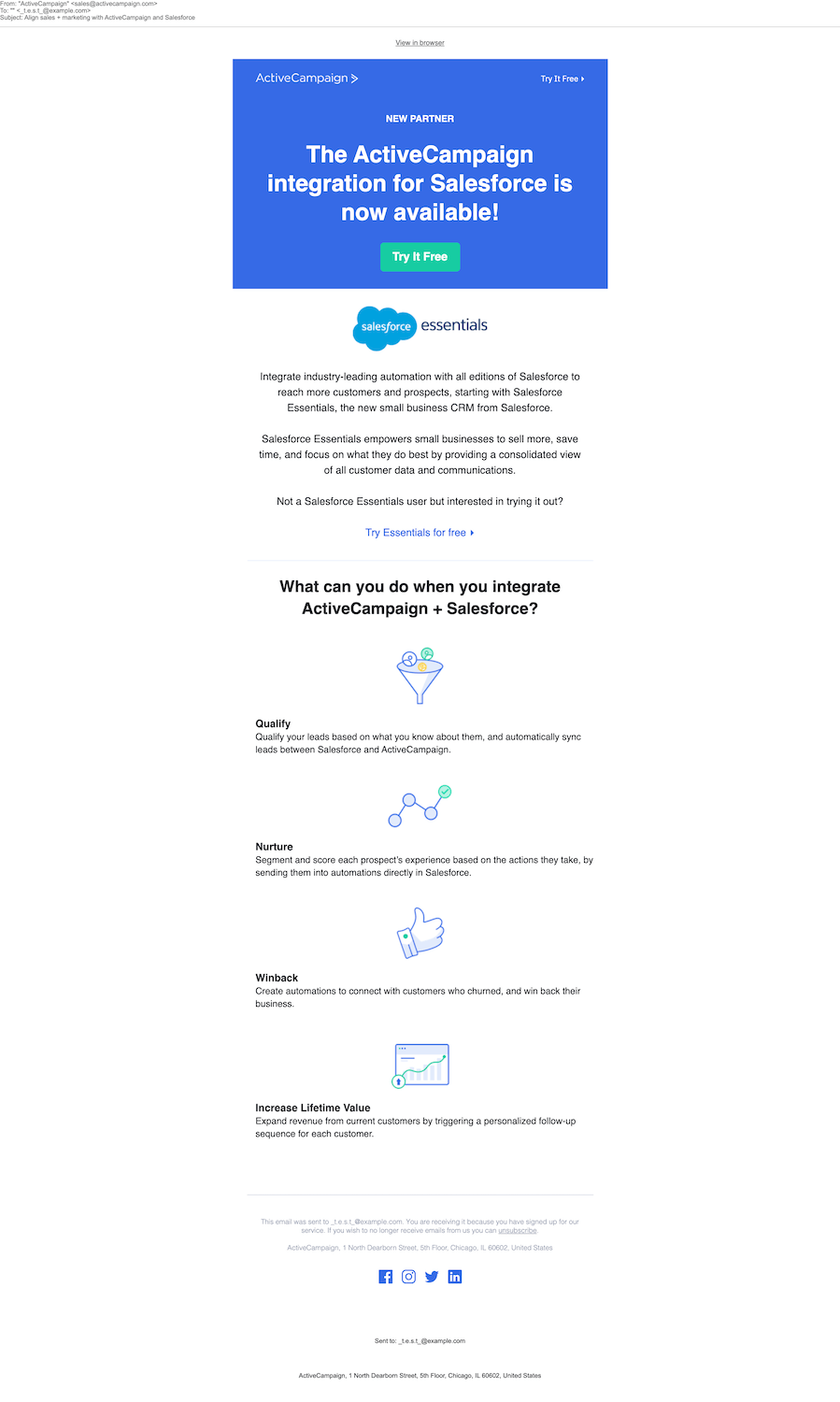
Later this month, ActiveCampaign published a blog post about 11 Salesforce automations — bringing those use cases from the integration discovery phase to the spotlight.
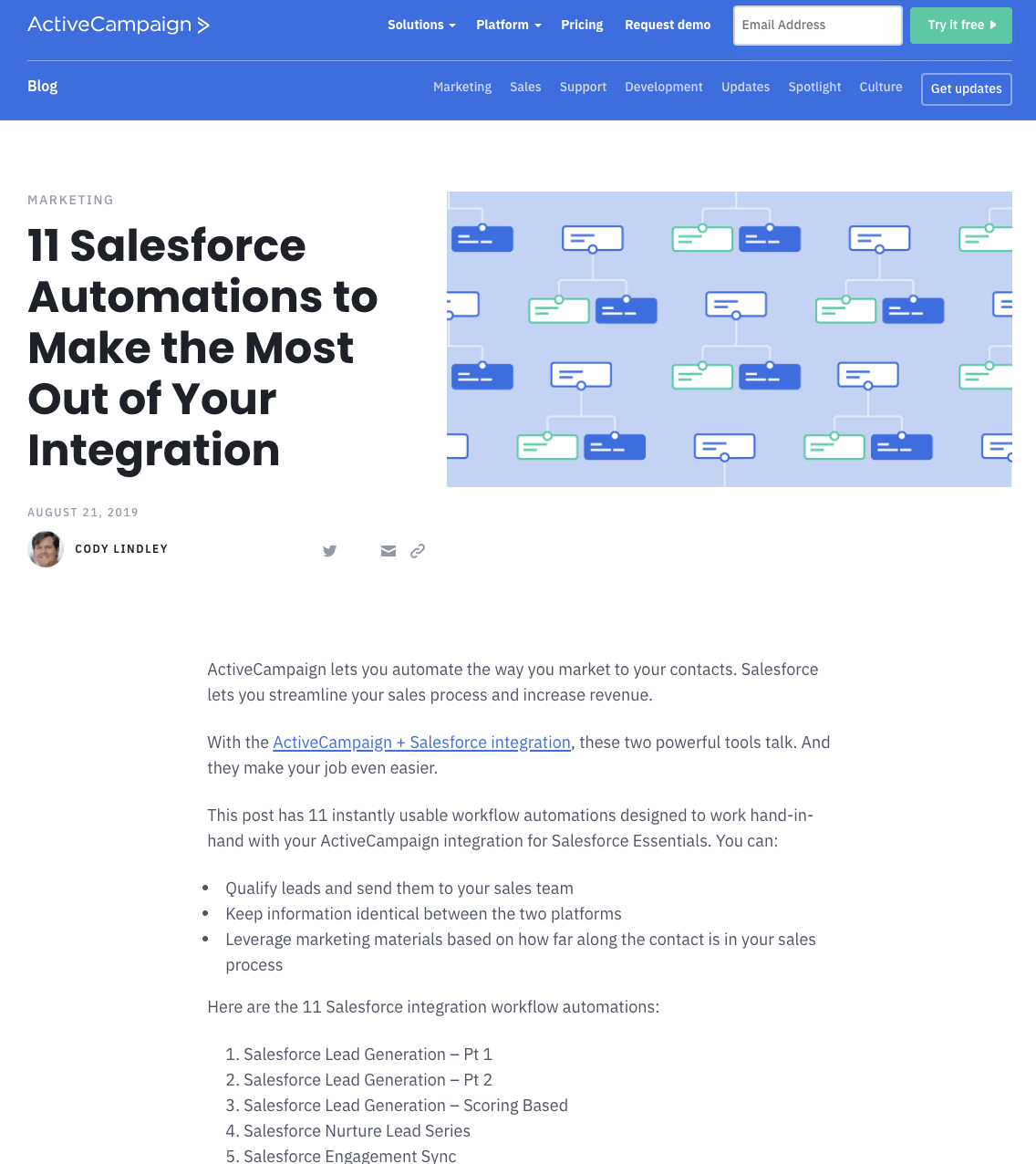 Excerpt from a blog post on ActiveCampaign’s website
Excerpt from a blog post on ActiveCampaign’s website
That same day, ActiveCampaign published “How to Build Your Marketing Stack: The 10 Best Tools” with a plug for the Salesforce integration under the CRM section.
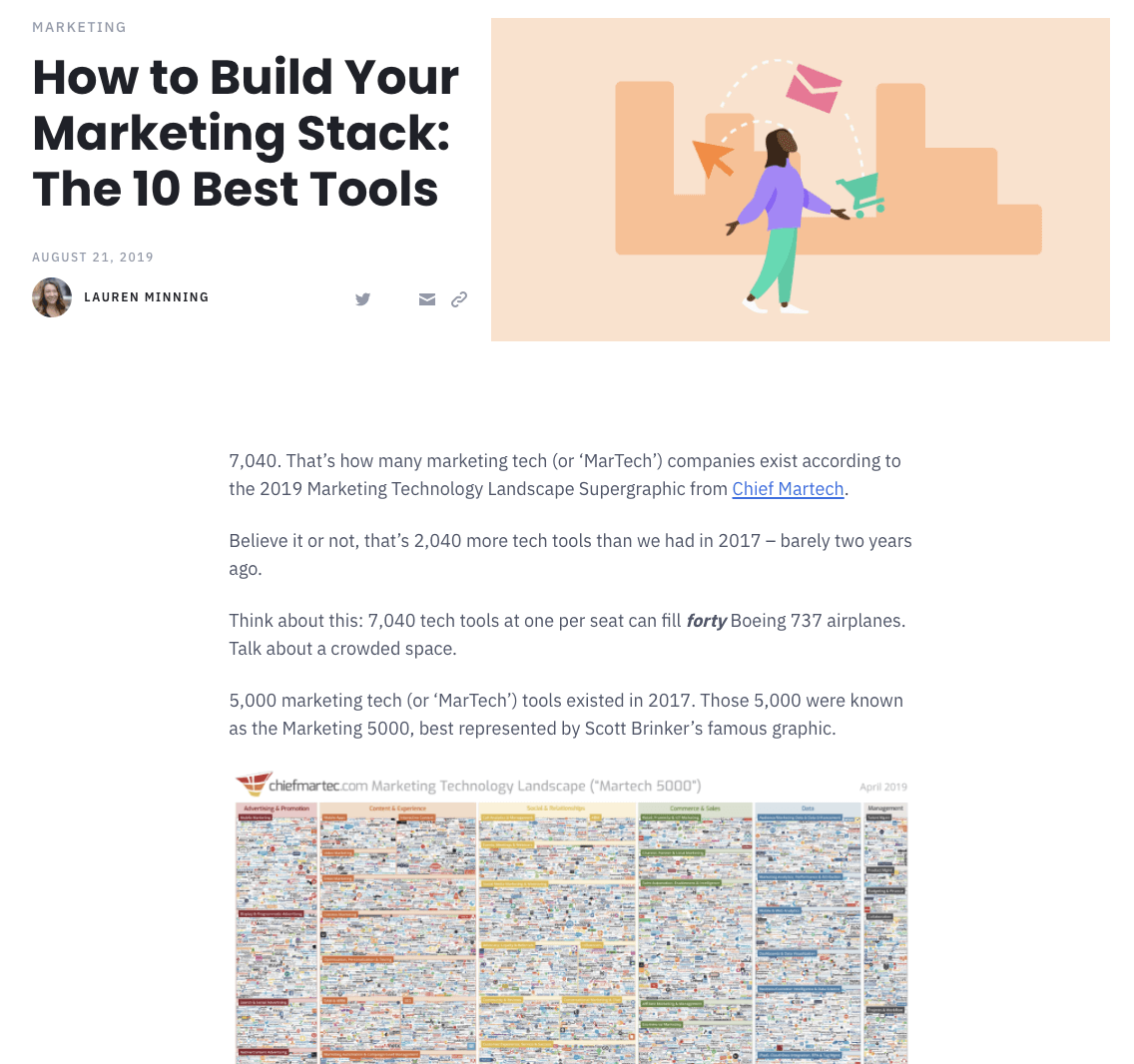 Excerpt from a blog post on ActiveCampaign’s website
Excerpt from a blog post on ActiveCampaign’s website
Remember those Study Halls ActiveCampaign hyped up a few weeks prior at Digital Summit? Members of the ActiveCampaign team now returned to Atlanta, the hosting city for May’s Digital Summit, to host a Study Hall with 30-50 of the customers they engaged with weeks prior.
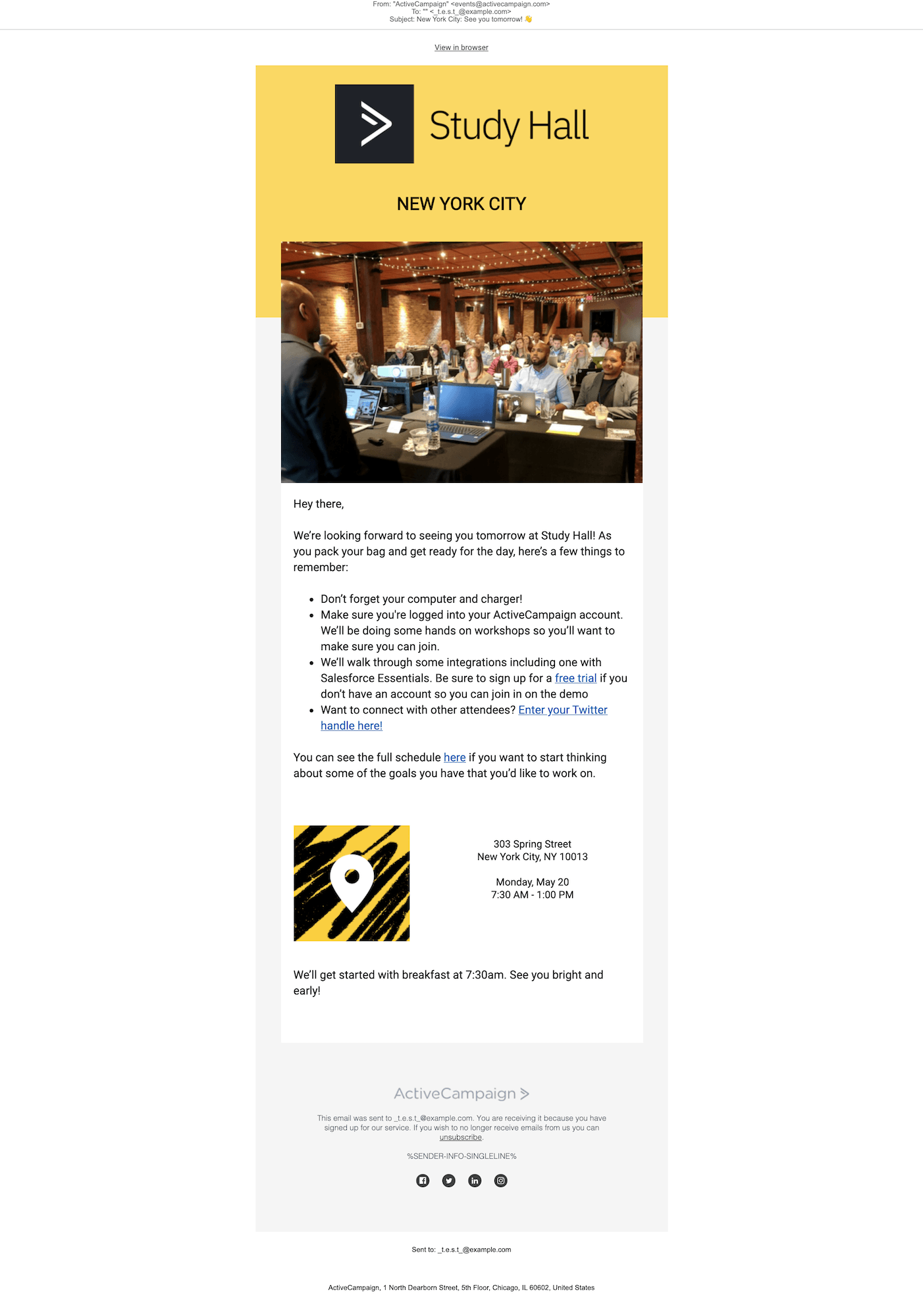
An invitation for Study Hall in NYC
Think of Study Hall as a full day, platform deep dive that helps ActiveCampaign customers discover better workflows and custom solutions using the platform’s automation recipes.
“They’re hands on,” says Howe. “We ask, ‘What problems do you have in your business?’ Let’s whiteboard out what an automation could look like, and let’s build that in your account. We do this with 50 of us, and folks watch and ask questions as we go through it.”

The ActiveCampaign team also makes sure to zoom in on the Salesforce integration specifically to solve for its relevant use cases.
“‘If you’re using ActiveCampaign and you’re using Salesforce, share how you’re using each. Show us your customer life cycle,’” explains Howe. “And then we’re helping, ‘This is how you want to tie these together — how you want to pull in the various feedbacks or sync data across the platform.’”
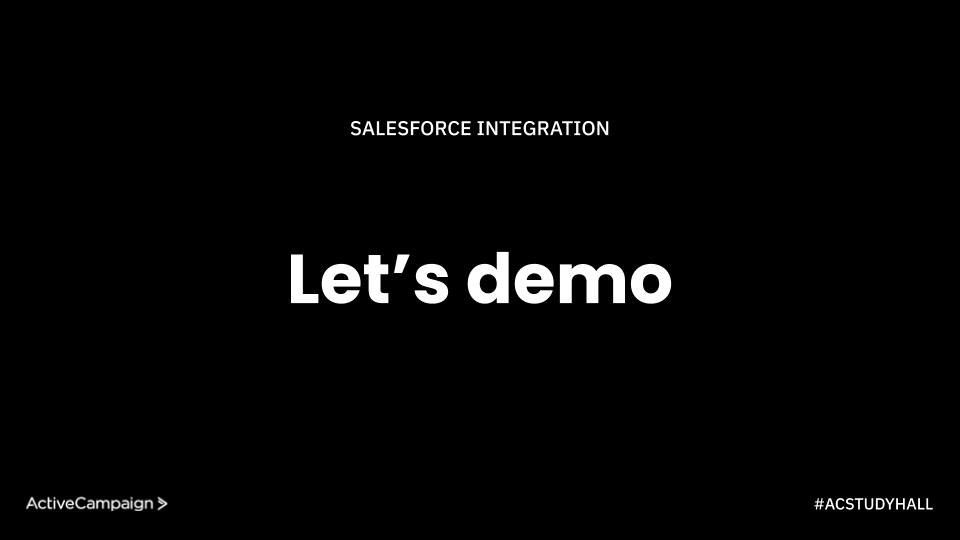

For handouts at the event, the ActiveCampaign team printed custom notebooks, stickers, and one-sheets explaining the integration and promoting the free trial for attendees to scoop up. They also included plugs for their community resources — Facebook, Slack, and their forum — as well as their education portal for further learning.
Sometimes, it’s the little details that polish off an already well-developed event series.

To recap, ActiveCampaign cast a wide net at the Digital Summits and then used that momentum to engage high-quality leads for a more intimate event to follow.

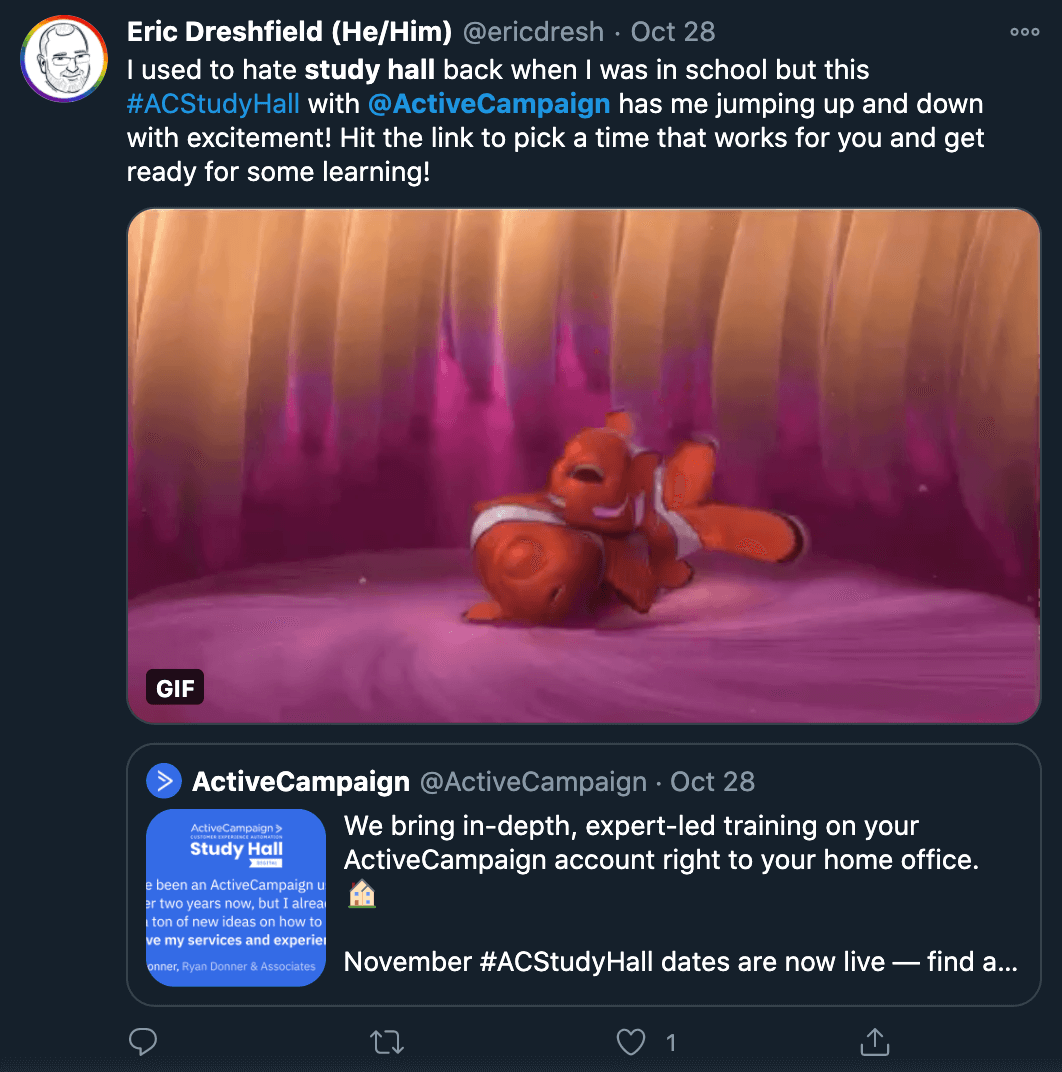
Disclaimer: In 2020, ActiveCampaign had to bring their events online (fast forward to see how).
September 2019 (One Month After Launch)
To celebrate the launch and keep the momentum going, ActiveCampaign hosted a launch party in their home city, Chicago.
 Excerpt from ActiveCampaign and Salesforce’s integration launch party invitation
Excerpt from ActiveCampaign and Salesforce’s integration launch party invitation
October 2019 (Two Months After Launch)
With their early adopters already seeing the effects of the integration, ActiveCampaign began to publish joint case studies — the first of which was with the Museum of Science and Industry, Chicago (MSI).
At the top of the case study page, you’ll find a video where MSI employees speak about their pride for the museum, ultimately leading into the success they’ve seen using the integration.
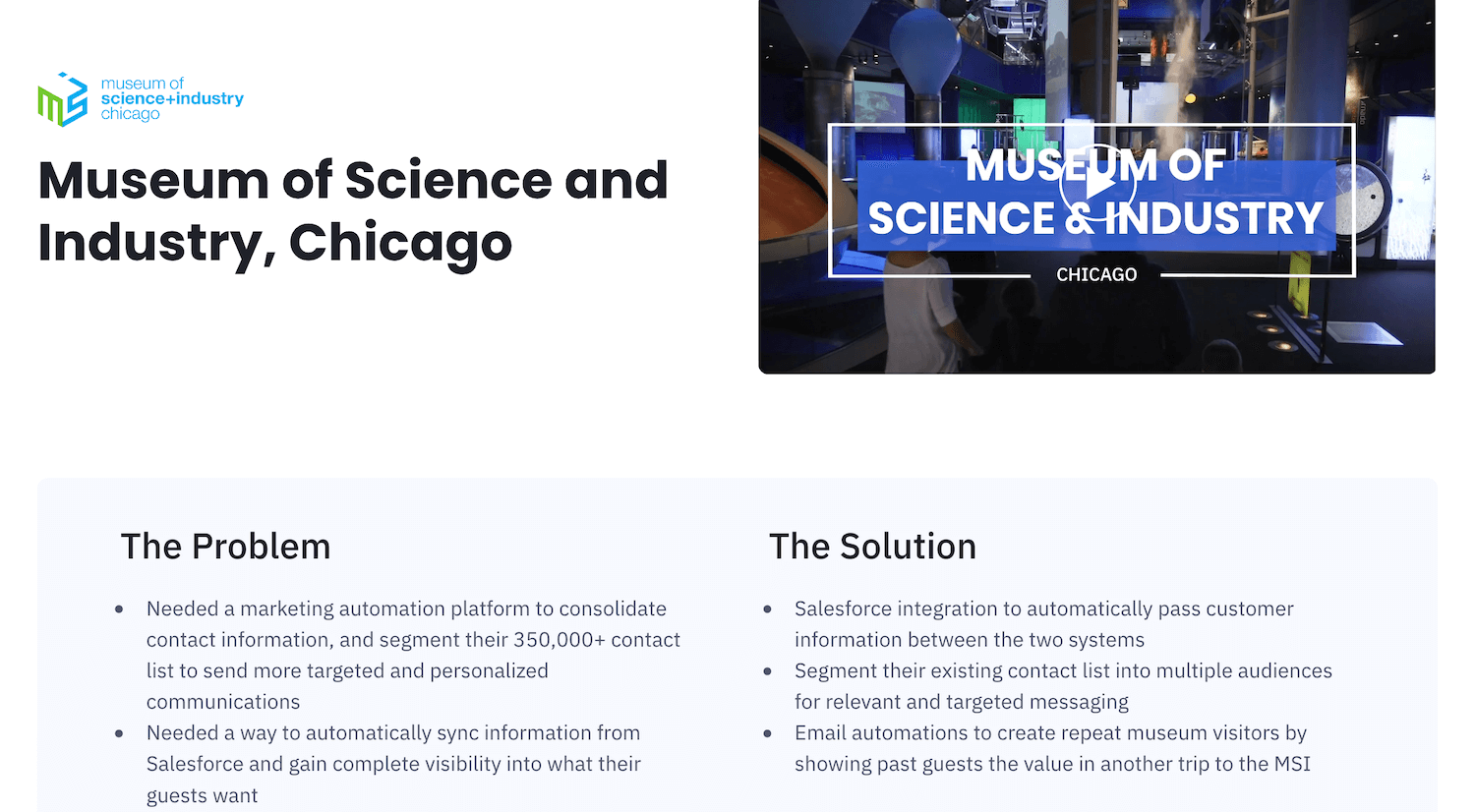 Excerpt from the Museum of Science and Industry, Chicago, case study
Excerpt from the Museum of Science and Industry, Chicago, case study
 Excerpt from the Museum of Science and Industry, Chicago, case study
Excerpt from the Museum of Science and Industry, Chicago, case study
November 2019
Then, ActiveCampaign posted a case-study-style video about how Thinkific leverages the integration to close more deals.
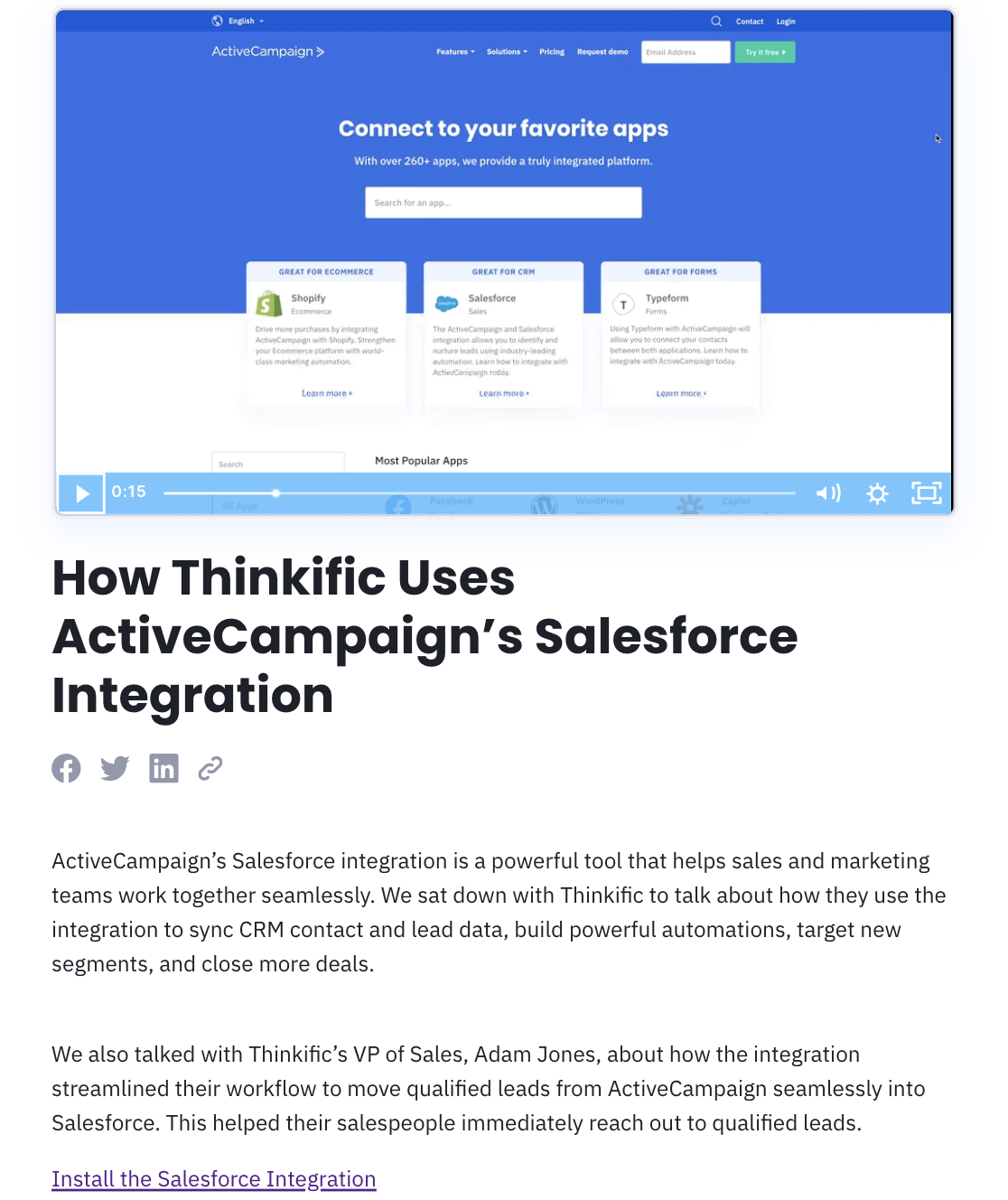 Excerpt from the Thinkific case study
Excerpt from the Thinkific case study
December 2019 (Four Months After Launch)
Cue the victory bells! ActiveCampaign is officially #1 in Salesforce’s Marketing Automation AppExchange — about six months after their first co-marketing initiative together at Digital Summit back in May and just four months after their public launch.

In case you’re wondering, there’s no special notification when you achieve the #1 spot. It’s more of a, “Wait, what? We’re number one!” type of moment.
?
Everything That is 2020
Much of ActiveCampaign’s success flowed from their ability to engage with their customers at events. Unsurprisingly, these events took a nosedive in 2020, and ActiveCampaign’s Study Halls went fully online. But they’re still seeing a lot of success and have adapted their Study Hall series to accommodate their customers’ shifting schedules. What was a one day event is now a three day event across a few weeks.
Howe says they measure the success of these online events by two factors: attendance and engagement afterwards.
As you can see from the “Sold Out” events below, their online Study Halls are doing pretty well.


This Tweet brings folks to a landing page where they can learn about the Study Halls and reserve their spot.

We’d also like to point out that ActiveCampaign makes it really easy for customers and prospects to learn about all of their integrations in their education center.

When asked how they’re revisiting their partnership strategy to level up on their work thus far, Howe says they’re looking more closely at their platforms for branding opportunities.
“We’re beginning to go deeper in how to expose each other’s brands on the platforms. In ActiveCampaign today, we have automation events or actions that are branded for Salesforce,” says Howe. “Likewise, inside Salesforce, you have an ActiveCampaign branded activity stream. You can see who’s opening your emails, what they’re doing on your website. All that tracking is getting exposed into Salesforce for sales reps. We’re branding those activities across the platform.”
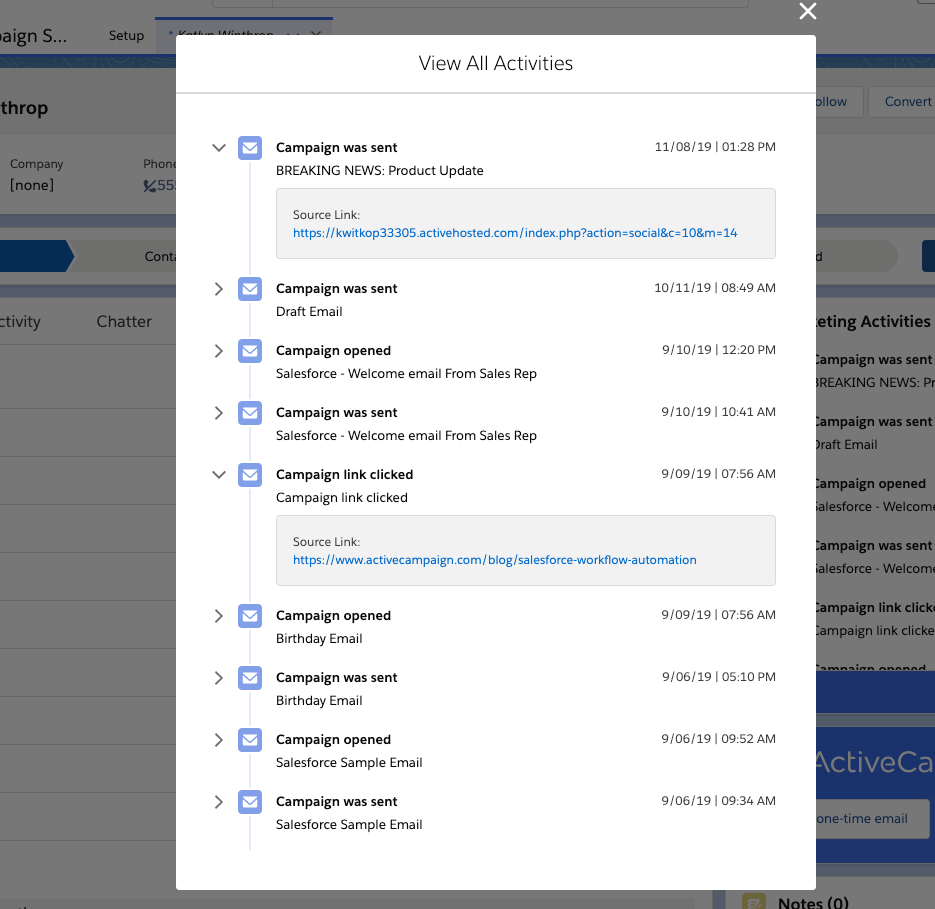

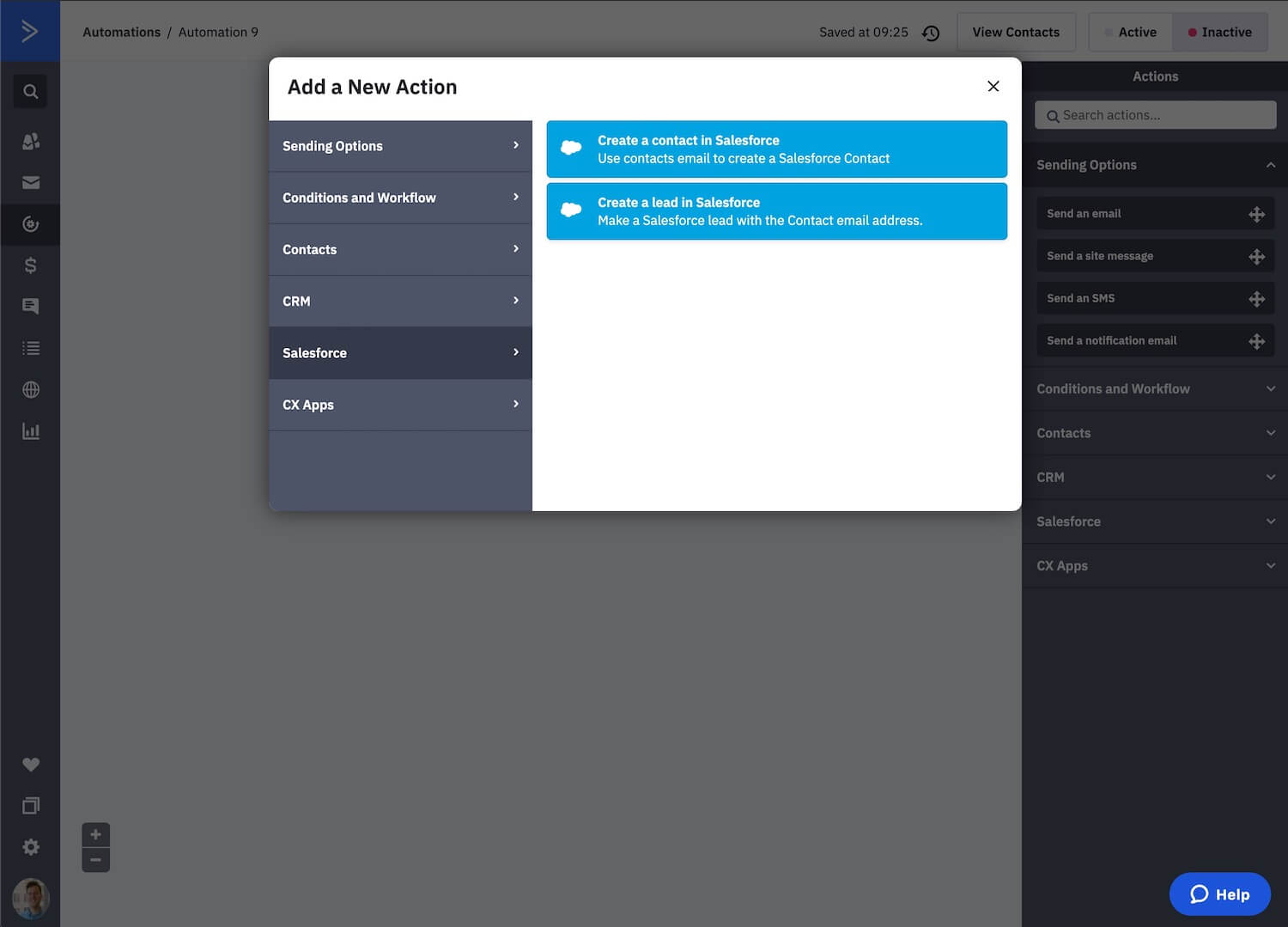
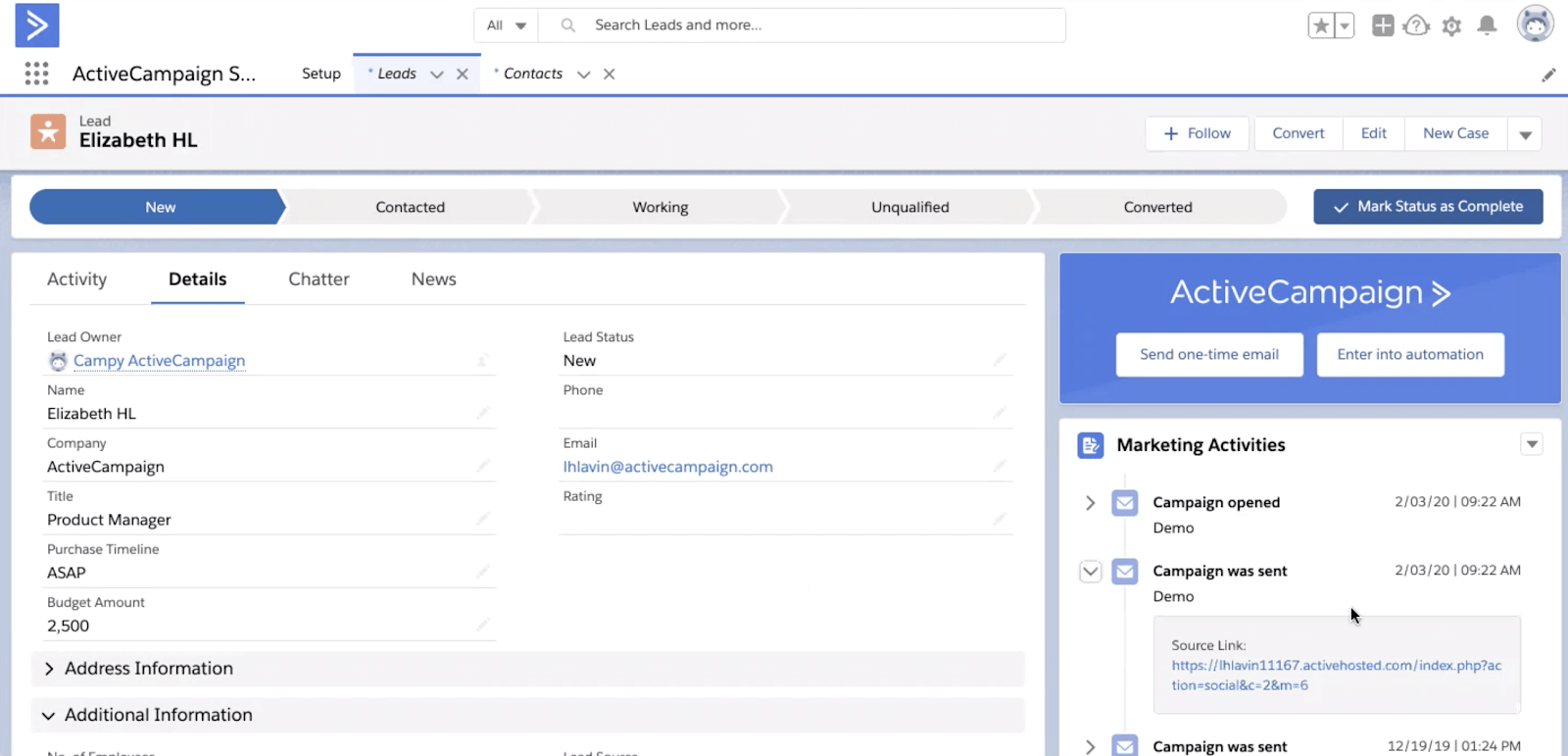
ActiveCampaign believes in their Salesforce partnership so much that they now have an entire engineering team (as of early 2020) and a marketer (as of late 2020) fully dedicated to the Salesforce integration.
—
Thanks for taking the co-marketing journey with us. Before we get to your don’t-miss-a-beat-comarketing-checklist, we’ll leave you with this:
The most successful campaigns are not just a GTM (go-to-market campaign). It’s, “How do we run the life cycle of this? How do we continue to grow together?” says Howe.
(By the way, if you’re looking for inspiration for your partner pages or partner newsletter, we’ve got you covered for that, too!)
Your Don’t-Miss-A-Beat-Comarketing-Checklist:
(Psst! Don’t forget to test everything before launch!)
Go-to-Market Prep:
- Create the copy and images for the dedicated listing pages on your AppExchange (if applicable) and your partner’s AppExchange
- Provide your logo for your integration listing in the main directory
- Decide where else to feature buttons for easy access to a specific integration — a spotlight section on your AppExchange directory, in your top navigation, in your bottom navigation
- Consider putting an announcement and CTA for the integration on your main customer login page
- Create the copy and images for a help center page to explain how to set up the integration, with screenshots and videos if applicable
- Develop copy and images for your co-branded landing pages on your website and your partner’s
- Create the copy and images for a trial offer form
- Develop the copy, images, and video content for your partner page, if applicable
- Decide if and how you’ll make early integration announcements or teasers for select groups of customers at events or otherwise (Hint: Find a way to catch their attention early and plant the seed right then and there to re-engage them at an event, through a report, or some other initiative you have in the works for later).
- Ahem, plan that other initiative mentioned above! (Will you plan a follow-up event for a platform deep dive with customers? If so, you’ll need registration landing pages, a promotion schedule and copy for social media and email marketing, at-event handouts, e-mail outreach copy for your customer success and/or sales team, and so on)
Launch Day Prep:
- Prepare copy for your press release and determine which distribution channel to use (PR Newswire, Business Wire, and so on)
- Prepare copy and images for your integration announcements on your blog, email newsletter, social media channels, and anywhere else you plan to announce (platform login pages, pop-up notifications on your website, a banner, and so on)
- Prepare copy and images for your blog swaps, if applicable, and identify avenues for plugging the integration news into other content pieces your team is working on (Basically, sync up with your content team to chat through the opportunities!)
- Gather value statements from your early adopters for potential inclusion in your press release
- Develop joint case studies, if applicable at this point in time, to showcase a customer’s success with the integration and help you make the case to other customers (Also consider case-study-style-videos)
- Prepare your paid advertising campaigns
- Determine whether or not you’re going to A/B test promotions for the integration through different versions of copy for your website’s pop-up windows, customer login page, and so on
Post-Launch:
- As you notice more opportunities to engage your customers with the integration on your site (perhaps you’ve seen more traffic on your blog, or you’ve noticed searches in your site search with a high bounce rate), create more resources, more buttons, and more pages to satisfy those needs (Think: a help center page, a partner page, and so on)
- Keep the momentum going with the events, webinars, and other initiatives you’ve brought to various markets so far by leveling up with a “Part II” or “Advanced” series to go deeper into the platform or share new findings you’ve developed with your partner (Think: A Forrester report)
- Continue gathering case studies, value statements for your website, and G2 reviews from customers for posting on your website
- Plan time to revisit the partnership as a whole a year or so in to determine if you should shift your strategy and to plan the next year’s wave of co-marketing touchpoints
- If you’ve “made it to #1” (or a similar kind of success), celebrate it! Share the news on socials, in your email newsletter, on your website’s homepage, and so on



